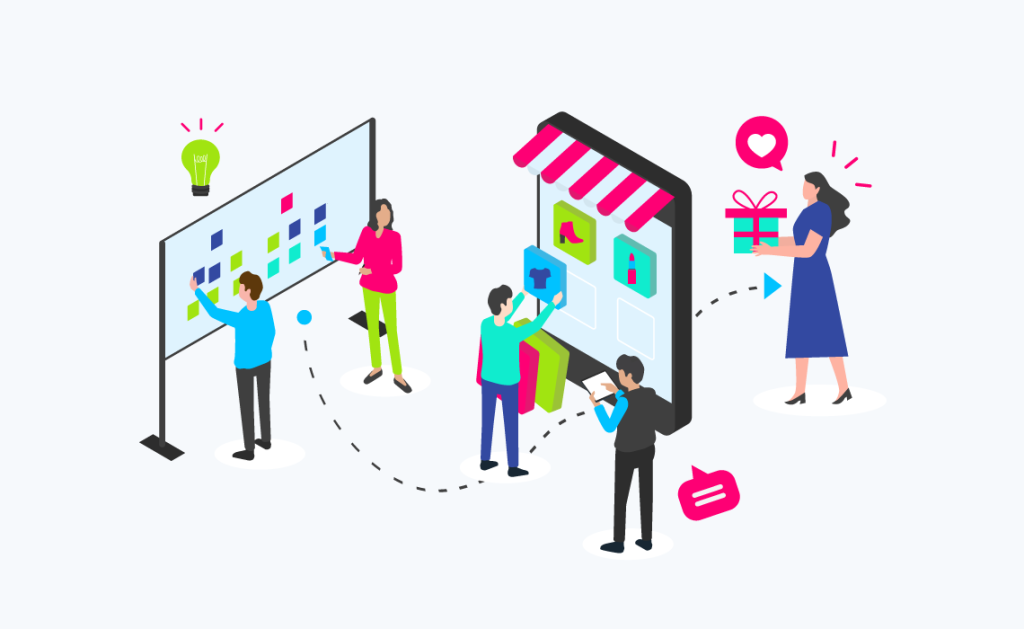Written By:
Scott McAuley
Scott is the IT Director of Texas Management Group, and has been in the IT industry for 25 years.
The world of digital commerce is transforming faster than ever. But what is digital commerce? It’s more than just selling online—it’s the entire ecosystem of digital transactions, from mobile shopping to AI-driven customer experiences.
In 2024, this space is set to see even more exciting developments. Businesses that understand and adapt to these trends will stay ahead in the competitive landscape.
So, how will these shifts impact your business? And what should you keep an eye on in the coming year?
Let’s explore the 15 dynamic trends shaping digital commerce in 2024!
Key Takeaways:
- Digital commerce encompasses the entire ecosystem of online transactions, including mobile shopping, AI-driven experiences, and customer engagement across digital platforms.
- In 2024, mobile commerce, AI, and personalization will drive significant changes, shaping how businesses operate and engage with customers.
- Omnichannel retail is becoming essential, integrating online and offline channels to create seamless shopping experiences across multiple touchpoints.
- Artificial intelligence and machine learning are transforming customer experiences by offering personalized recommendations and automating various digital commerce processes.
- Fast delivery options, including same-day and next-day shipping, are becoming crucial for staying competitive in the digital commerce landscape.
Table of Contents
What is Digital Commerce?

Digital commerce is all about buying and selling goods or services online through digital channels. It covers everything from online retail to secure online transactions.
In today’s fast-changing e-commerce world, digital commerce is reshaping how businesses operate and how customers shop. It offers incredible convenience to both parties, allowing purchases to happen anytime, anywhere.
Digital Commerce vs. E-commerce
When it comes to running an online business, people often mix up e-commerce and digital commerce. While they may seem similar, they serve different purposes.
Let’s break it down simply:
| Aspect | E-Commerce | Digital Commerce |
|---|---|---|
| Definition | Buying and selling products online. | Includes e-commerce but covers more digital activities. |
| Scope | Primarily focuses on online sales. | Goes beyond sales to include engagement, data, and personalization. |
| Business Model | Typically online-only businesses. | Combines online and brick-and-mortar stores. |
| Customer Interaction | Mostly focused on transactions. | Adds engagement and personalization to the experience. |
| Physical Store Presence | Usually limited to online stores. | Integrates online and physical stores. |
| Industry Disruption | Drives online-only business models. | Transforms traditional retail by merging physical and digital. |
How Does Digital Commerce Work?
Digital commerce uses online platforms to sell products and services worldwide. It allows businesses to engage with customers in real time and conduct seamless transactions.
Efficient supply chain management and shipping logistics are critical to success. They ensure smooth operations from sourcing materials to delivering products.
Technology plays a big role in optimizing inventory, order fulfillment, and shipping logistics. This keeps operations running efficiently and meets customer demands.
Meeting customer expectations is key to thriving in digital commerce. Customers want personalized experiences, convenience, and fast delivery.
Businesses gather and analyze customer data to create tailored marketing campaigns. This boosts customer satisfaction and increases conversion rates.
Tools like customer analytics provide insights into behaviors and trends. They help businesses make informed decisions and build customer loyalty.
In short, digital commerce helps companies expand, improve operations, and deliver excellent customer experiences. It relies on supply chain efficiency, personalized marketing, and data-driven strategies.
Why is Digital Commerce Important?
Digital commerce plays a crucial role in today’s business world. It has transformed how people shop and reshaped the entire online shopping experience.
Here’s why digital commerce is so important:
- Improved Customer Experience: Online shopping platforms offer personalized recommendations. This makes the process more efficient and enjoyable for customers.
- Global Reach: Businesses can expand beyond geographical boundaries. Digital platforms enable companies to tap into new markets and attract customers worldwide.
- Scalability: Unlike physical stores, online businesses can easily scale to meet growing demand. This flexibility helps businesses handle large customer bases without the need for physical expansion.
- Cost-Efficiency: Operating an online business reduces costs by eliminating the need for physical storefronts. This allows companies to offer competitive prices while maintaining profitability.
10 Digital Commerce Examples
Digital commerce spans various industries, allowing businesses to offer goods and services through digital platforms.
Let’s explore some key examples:
| Example | Description |
|---|---|
| Online Retail | Selling products directly through digital platforms. |
| Digital Marketplaces | Multiple sellers offer products on one platform. |
| Subscription Services | Recurring payments for regular access to services. |
| Digital Downloads | Purchasing digital content like music or e-books. |
| Online Travel Booking | Booking flights, hotels, and rentals online. |
| Food Delivery | Ordering food from local restaurants for delivery. |
| Online Education | Remote access to courses and certifications. |
| Digital Banking | Managing finances through online and mobile platforms. |
| Virtual Events and Conferences | Hosting meetings and events virtually. |
| Digital Health Services | Telemedicine and remote health monitoring. |
1. Online Retail
Online retail involves selling products directly to consumers through digital platforms. Popular examples include Amazon, Walmart, and Target. These platforms offer a wide variety of products that customers can easily browse and purchase online.
2. Digital Marketplaces
Digital marketplaces bring multiple sellers together on one platform. eBay, Etsy, and Alibaba are examples where businesses and individuals can sell products to a broader audience. Customers can compare options and make informed decisions.
3. Subscription Services
Subscription services charge a recurring fee for access to products or services. Netflix, Spotify, and HelloFresh are common examples. These services provide a personalized and hassle-free experience for customers.
4. Digital Downloads
Digital downloads refer to purchasing content like music, e-books, and software online. Platforms like iTunes, Amazon Kindle, and Steam allow customers to instantly access their content without physical media.
5. Online Travel Booking
Online travel booking platforms such as Expedia, Booking.com, and Airbnb let customers book flights, hotels, and rental cars online. These services make comparing prices and planning travel convenient and flexible.
6. Food Delivery
Food delivery services like Uber Eats, Grubhub, and DoorDash connect customers with local restaurants. These platforms offer a convenient solution for ordering food and getting it delivered straight to the door.
7. Online Education
Online education platforms provide remote access to courses and certifications. Coursera, Udemy, and Khan Academy are examples that offer flexibility and a wide range of educational resources.
8. Digital Banking
Digital banking allows customers to manage their finances through online and mobile platforms. Bank of America, Chase, and PayPal offer secure and convenient banking services.
9. Virtual Events and Conferences
Virtual platforms like Zoom, Microsoft Teams, and Cisco Webex host events, conferences, and meetings online. These tools enable participants to connect and collaborate remotely.
10. Digital Health Services
Digital health services provide telemedicine and remote patient monitoring through platforms like Teladoc, Doctor on Demand, and Fitbit.
These services give patients convenient access to healthcare professionals and tools to monitor their health.
5 Types of Digital Commerce
Digital commerce encompasses different types of transactions conducted online. Understanding these types is crucial for businesses looking to establish an online presence and engage in online transactions.
Below are five types of digital commerce:
1. Business-to-Consumer (B2C)
B2C digital commerce involves businesses selling products or services directly to individual consumers. It is the most common type of digital commerce and is widely seen in online retail platforms such as Amazon and Walmart.
2.Business-to-Business (B2B)
B2B digital commerce refers to transactions between two or more businesses. It involves the procurement of goods and services by one business from another. For example, a manufacturer purchasing raw materials from a supplier via an online platform.
3. Consumer-to-Consumer (C2C)
C2C digital commerce involves consumers buying and selling goods or services directly to other consumers on online platforms. Popular examples of C2C transactions include online marketplaces like eBay and Craigslist.
4. Consumer-to-Business (C2B)
C2B digital commerce occurs when individual consumers provide products or services to businesses. This can include freelance services, influencer marketing, or user-generated content. Platforms like Upwork and Fiverr facilitate C2B transactions.
5. Business-to-Government (B2G)
B2G digital commerce involves businesses providing goods or services to government entities. This can include government contracts, online bidding, and procurement processes. Websites like FedBid and GovWin enable B2G transactions.
Key Components of Digital Commerce
Digital commerce thrives on several key components that ensure smooth transactions and personalized experiences. These elements shape the digital landscape and drive business success.
Online Platforms
Online platforms are the backbone of digital commerce. They allow businesses to sell products, manage inventory, and create a seamless customer experience.
Payment Processing
Payment processing ensures transactions are secure and efficient. It allows businesses to offer multiple payment methods, including credit cards and digital wallets.
Supply Chain Management
Supply chain management ensures goods are delivered on time. It helps businesses stay competitive by optimizing logistics and inventory.
Customer Data
Customer data provides insights into consumer behavior and preferences. This allows businesses to personalize marketing and improve customer satisfaction.
Customer Experience
A positive customer experience drives repeat business and loyalty. It’s achieved through intuitive navigation, responsive support, and personalized communication.
15 Digital Commerce Trends
In the rapidly evolving world of digital commerce, businesses need to stay ahead of the trends shaping the industry.
These 15 dynamic trends are set to transform the digital commerce landscape in 2024:
| Trend | Description |
|---|---|
| Mobile Commerce | Increasing use of smartphones for online shopping |
| Omnichannel Retail | Seamless integration of online and offline channels |
| Voice Commerce | Shopping using voice assistants |
| AI and Machine Learning | Utilizing intelligent technologies to enhance the customer experience |
| AR and VR | Immersive shopping experiences through augmented and virtual reality |
| Social Commerce | Integrating shopping features into social media platforms |
| Personalization and Customer Experience | Delivering tailored experiences based on customer data |
| Subscription-Based Services | Offering flexible recurring services or products |
| Green and Sustainable Commerce | Embracing environmentally friendly practices |
| Contactless Payments | Safe and convenient payment options |
| Same-Day and Next-Day Delivery | Fast and efficient delivery options |
| Social Responsibility and Cause Marketing | Aligning with social or environmental causes |
| Headless Commerce | Separating front-end and back-end e-commerce functionality |
| Digital Wallets and Cryptocurrency Payments | Secure and convenient payment options |
| Live Commerce | Combining e-commerce with real-time livestreaming |
1. Mobile Commerce
With the increasing use of smartphones, mobile commerce is on the rise. Businesses must optimize their websites and platforms for mobile devices to provide a seamless shopping experience.
2. Omnichannel Retail
Omnichannel retail integrates online and offline channels, allowing customers to make purchases seamlessly across multiple touchpoints. This trend enhances convenience and improves the overall customer experience.
3. Voice Commerce
Voice commerce is gaining popularity with the rise of voice assistants. Customers can now make purchases using voice commands, making the shopping experience more convenient and efficient.
4. Artificial Intelligence (AI) and Machine Learning
AI and machine learning technology enable businesses to analyze customer data, personalize recommendations, and automate processes, thereby improving the overall customer experience and driving sales.
5. Augmented Reality (AR) and Virtual Reality (VR)
Virtual and augmented reality provides immersive shopping experiences, allowing customers to visualize products and try them virtually before making a purchase. This trend enhances customer engagement and boosts sales.
6. Social Commerce
Social media platforms are becoming powerful e-commerce channels. Businesses can leverage social commerce to engage with customers and drive sales by integrating shopping features directly into social media platforms.
7. Personalization and Customer Experience
Personalization is crucial for businesses to deliver tailored experiences that meet customer expectations. By analyzing customer data and behavior, businesses can provide personalized recommendations and enhance customer satisfaction.
8. Subscription-Based Services
Subscription-based models are growing in popularity across various industries. Customers prefer the convenience and flexibility of subscribing to products or services, leading to recurring revenue streams for businesses.
9. Green and Sustainable Commerce
Consumers are increasingly concerned about environmental sustainability. Businesses that adopt green and sustainable practices are likely to attract environmentally conscious customers and build a positive brand image.
10. Contactless Payments
Contactless payments have soared in popularity due to their convenience and safety during the COVID-19 pandemic. Businesses should embrace contactless payment options to cater to changing customer preferences.
11. Same-Day and Next-Day Delivery
Fast and efficient delivery options are becoming essential in the digital commerce landscape. Businesses that can offer same-day or next-day delivery gain a competitive edge by meeting customer demands for instant gratification.
12. Social Responsibility and Cause Marketing
Customers are increasingly drawn to businesses that demonstrate social responsibility. Cause marketing, where businesses align with social or environmental causes, helps build brand loyalty and attract socially conscious customers.
13. Headless Commerce
Headless commerce separates the front-end and back-end of an e-commerce platform, allowing businesses to deliver personalized customer experiences across multiple channels. This trend enhances flexibility and scalability.
14. Digital Wallets and Cryptocurrency Payments
Digital wallets and cryptocurrency payments provide customers with secure and convenient payment options. Businesses adopting these technologies can enhance the overall payment experience and appeal to tech-savvy customers.
15. Live Commerce
Live commerce combines e-commerce and live streaming, allowing businesses to showcase products in real-time. This trend is gaining traction as it offers a unique shopping experience and encourages immediate purchases.
How to Start in Digital Commerce
Starting in digital commerce requires smart planning and clear strategy. These steps will help guide you on building a successful online business.
- Develop a Digital Commerce Strategy
Begin by crafting a strategy that aligns with your goals and market. Identify your audience, understand their needs, and highlight your unique selling proposition. - Create an E-commerce Website
Your website is the core of your online business. Choose a platform with customizable features, and design a user-friendly site that’s optimized for mobile devices. - Develop Mobile Apps
Consider building mobile apps to reach a wider, mobile-first audience. Apps offer convenience, allowing users to shop anytime, anywhere. - Choose an Online Platform
The right platform is essential for success. Choose one that scales, offers security, and integrates easily with other tools. Popular options include Shopify, WooCommerce, and Magento. - Collect and Analyze Customer Data
Gather customer data such as purchase history and browsing behavior. This helps improve your operations and create a better customer experience. - Optimize for Customer Experience
Personalization is key. Use product recommendations and intuitive search functions to enhance the customer experience. Ensure fast checkout and responsive support. - Leverage Social Media and Online Advertising
Social media is a powerful tool for attracting customers. Combine it with online advertising and a clear digital marketing strategy to drive traffic to your site. - Implement SEO Best Practices
SEO drives organic traffic. Research keywords, optimize your content, and ensure your site is technically sound for search engines to boost visibility. - Stay Updated with Trends and Innovations
The digital landscape is always changing. Stay ahead by embracing AI-powered tools, chatbots, and voice commerce to meet modern customer demands. - Monitor and Adapt
Regularly review your digital commerce metrics like traffic and conversion rates. Be flexible and ready to adapt your strategy based on performance data.
Conclusion
Digital commerce is evolving rapidly, and staying ahead of the trends is crucial for businesses looking to thrive in 2024. From mobile commerce to AI-driven personalization, these innovations are reshaping how we buy and sell online.
By adopting these trends, businesses can enhance customer experiences, boost efficiency, and remain competitive in a fast-paced digital world. It’s essential to explore the tools and strategies that align with your goals.
Are you ready to leverage these insights? Stay engaged and explore more opportunities to lead in digital commerce.
Together, let’s embrace the future of commerce and unlock new possibilities for growth!
Enthralled by the Dynamic Trends in Digital Commerce?
Keep the exploration alive at texmg.com! Dive into more insightful blogs for expert insights, and don’t miss our affordable IT services to drive your digital success.
Let’s shape the future of commerce together
FAQ
What Do You Mean by Digital Commerce?
Digital commerce refers to the buying and selling of goods and services using digital channels such as the Internet, mobile devices, social media, and other electronic platforms.
What is the Difference Between E-commerce and Digital Commerce?
E-commerce typically refers specifically to online transactions, while digital commerce encompasses a broader range of digital interactions, including online sales, digital marketing, electronic payments, and customer engagement across various digital platforms.
What is E-commerce in Simple Words?
E-commerce, short for electronic commerce, is the process of buying and selling goods and services over the Internet, enabling businesses and consumers to conduct transactions electronically without physical interaction.
What are the Benefits of E-commerce?
The benefits of e-commerce include expanded market reach, lower operational costs, 24/7 accessibility, improved customer convenience, streamlined processes, better inventory management, and data-driven insights for targeted marketing and decision-making.






